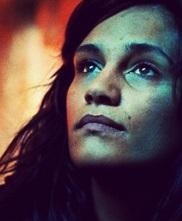Learning How to Breathe

For Sharon Connolly - who paved the way.
Coming to the surface, learning how to breathe, strip away the superfluous add ons, find a way to be found. On such a journey the profound and universal truths lie strewn along the road.
Shai Pittman as “Karen” takes us to the crannies of inner city Adelaide where Skinny, Jody, Anita, Vanessa, Genna and Gecko shelter from the storm of their lives with Big Red – the archtypal women’s shelter mentor and Cookie who puts the food on the table.
Karen is tormented by the memory of the death of a loved one and we follow her in the 24/7 negotiation of the contemporary inner city. It could be Glebe or Collingwood or the Valley or Fremantle. There are a hundred thousand Karen’s in our world.
Since the 1970s women at risk have been drawn to inner city havens. From the great ideological wars perhaps the enduring truimph of feminism has been the woman’s shelter – a place between the patriarchal family, the prison, the welfare bureaucracy and the harsh winds of normal life.
The prison and the factory, the welfare officer and the normal family assume that the whole, ever already normal individual goes through crises, makes mistakes, endures trauma and simply comes to the surface whole again.
But it is never that way. The great grass roots woman social activists of the last decade have discovered that the collective safe haven where stories can be shared and storms endured is an essential for learning how to breathe.
Outside of the capital cities such refuges in the Aboriginal community are spare rooms and lounge room couches. When you sleep in such places you sleep like a baby free of worries with tough angels who don’t say much and can at times treat you pretty rough. Often onlookers misunderstand they look in to a place where there are deep couches and frequently blanket beds on floors – these are the cocoons of healing.
Is the personal damage or the ravages of life ever so profound that it cannot be fixed? I kept on thinking of seeing Ruby Hunter and Archie Roach play at the Bogong Moth festival in the mountains of Victoria a year or so ago. Ruby took this healing cocoon with her where ever she went. She and Archie I get the feeling were like a sort of passing inspiration for the characters of Karen and Jeff (Paul Carter) in this movie. Ruby and Archie created their own family a new “Mum” and “Dad”. Nothing cannot be healed. But some things take more time, more time in the group healing cocoons than others.
I also thought of a conversation I had in Shepparton recently. Living this modern life is a 24/7 negotiaton for an Aboriginal person. There are so many points in which the negotiation breaks down. To truly heal the great profound personal traumas that occur more often than for any other Australian community, we need to invent many different healing places for women and men. Football clubs, refuges, private lounges and spare rooms, backyard fireplaces where you can have a bit of a sing song.
Marcia Langton who plays Lois in this movie will cause many to sit back and look at her with new respect. Here is the perfect portrayal of tough love. The unspoken and unseen aspect of Karen’s character is her prior addiction to drugs. Whether it be hard drugs or alcohol the easiest path for a close relative is to invest in the habit and to not challenge the individual. To do so is to endure the wrath of hell, the shuns of a hating stranger and the transformation of a son or daughter or husband into a growling werewolf. But there is no walking away from such a confrontation. It has to occur on the healing path.
Marcia’s slap of Karen in the opening sequence of the movie is one of the memorable moments of contemporary Australian cinema.
With Here I Am Beck Cole continues the triumphant march of Samson and Delilah. Seeing movies like this makes you feel very proud of the creative renaissance of Indigenous film makers and writers. It makes the stupid pre-occupations of those who see film as another commodity whose worth can be judged by the amount of money it makes at the box office seem inappropriate and ridiculous. Movies like this are worth more than a million sorries. They create our new cultural fabric. They give us a chance to live with one another successfully. Measure the worth of that in dollars I defy you. Worth more than a million offshore LNG wells in my estimation. A must see movie for Australian human beings.
Finally a word about the cast and the team. This is one of the most memorable acting ensembles we will ever see in an Australian movie. Shai Pittman's facial expressions will stay with me for a very long time. Tanith Glynn-Maloney's portrayal of Jody was extremely moving and funny. Betty Sumner as Anita jumped out of the screen and sat down with you in the cinema. Pauline Whyman as Skinny was the archetypal mate and the support performances of Bruce Carter, Yanja Thompson, Misty and Rhianon Sparrow and the unforgettable Carol Collins and even young Quinaha Scott were a perfect complement. Building performances like these seems to be Beck Cole and Warwick Thornton’s signature tune. Their teamwork and spirit shines through the screen. Look for Skinny, Jody, Anita, Vanessa, Genna and Gecko on a random inner city community street corner or on the platforms of train stations from St Marys to Broadmeadows or on the bus in Miller. Think of Big Red as the every woman of the woman’s shelter and, of course, do not get on the wrong side of Lois. A triumph!


